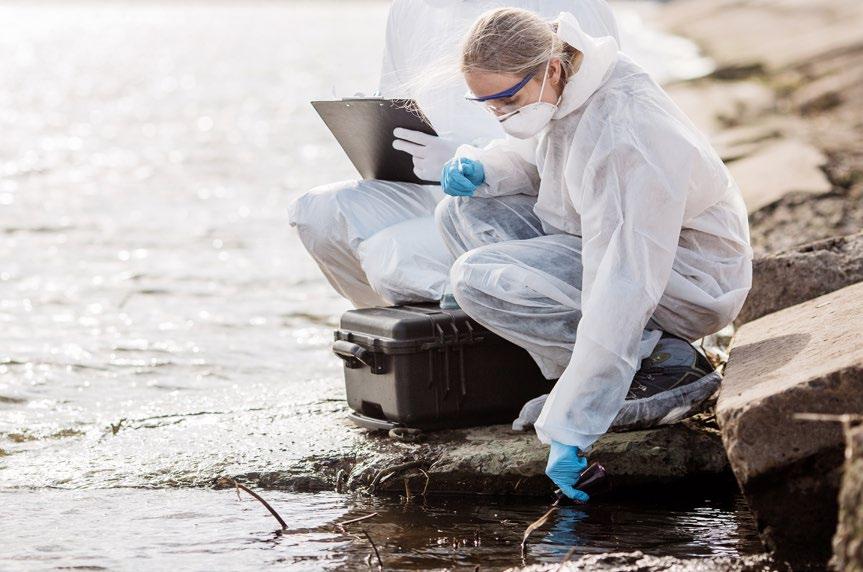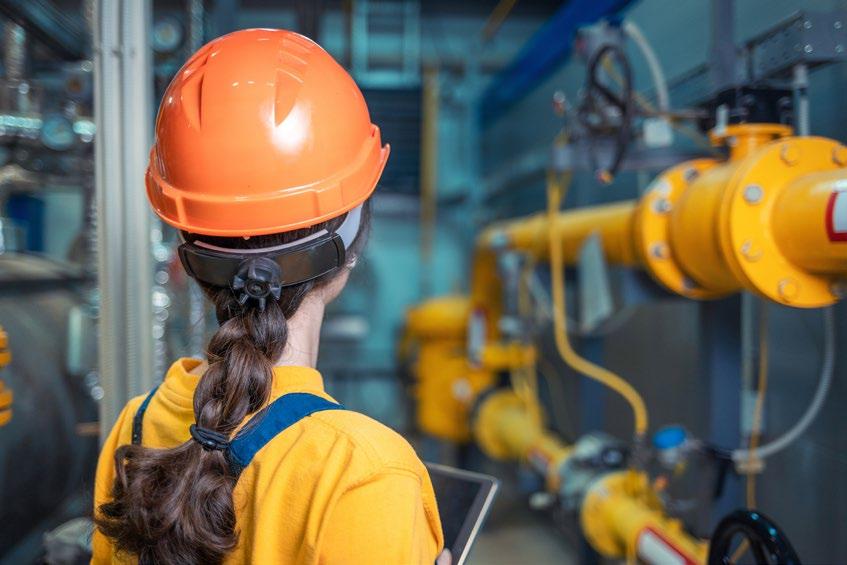
12 minute read
Technology that saves 69,000 gallons of water per year


Advertisement








Spotlight: The changing face of the water industry


Across the global water sector there are amazing women leading successful companies, innovating new technologies and inspiring the next generation of woman entrepreneurs to enter the industry. In this section, we spotlight these incredible individuals - who are tackling some of the greatest water challenges we face today.






Ainhoa Lete
President, BuntPlanet
1. What inspired you to start your company?

The inspiration to create BuntPlanet came from various different sources. On the one hand, I was fortunate to be able to meet and be inspired by successful founders of multinational companies from a very young age. The examples they provided were an inspiration to me. At the beginning of my professional career, as an engineer working at Siemens in Munich, I was deeply impacted by the innovation taking place around me. I realised that I could make a positive contribution to the innovation ecosystem by founding a company in San Sebastián, to tap into the extraordinary pool of talent emerging from the universities of the Basque Country. San Sebastian is not only an important tourist destination but a hub for science and research. I believe science and technology should contribute to improving the planet, I studied engineering precisely for that reason, to help solve problems. It is essential for us to preserve our scarce fresh water resources, which are critical for life on earth. Artificial intelligence can contribute significantly to improving the management of water. My vision is for BuntPlanet to improve the planet, with the help of our technology.
The water sector faces several key challenges. On the one hand, the emergence of new pollutants; and on the other, the effects of climate change. Climate change is increasing both the intensity and frequency of droughts and flood events. Meanwhile, water companies generally face budget constraints: In much of the world, the water tariff does not cover operating costs; the distribution networks are very old; and the rate of water reuse is low. Therefore, operational efficiency within water distribution networks must be enhanced to the maximum levels possible.
The combination of technologies offered by our BuntBrain solution - including artificial intelligence, Big Data and hydraulic simulation - is key to improving the management of water operations. With BuntBrain, water companies can detect and pre-locate early leaks before they grow and cause a burst. BuntBrain can simulate different scenarios, detect water quality problems, determine which meters need to be checked or replaced from an economic point of view and which pipes need to be replaced. The system also notifies users if they have an internal leak or if their consumption is abnormally low compared to similar users.
3. What are your goals for your company?
I would like BuntPlanet to be recognized for developing world leading artificial intelligence applications for the water sector. We are making significant investments in R&D with this objective in mind. Siemens, has chosen our solution which it is incorporating into its portfolio of digital water solutions. This endorsement by Siemens indicates that our technology is at the cutting edge and is beginning to gain the recognition we aim for. I would like BuntBrain to be used widely, throughout the planet, to achieve more efficient water management. Convincing the leading global water utilities to adopt our technology is one of our key goals. Some of the world’s most innovative water utilities already use BuntBrain. But, we also want to extend our coverage, so that our solutions are used even in small cities and in rural areas. At BuntPlanet we are firmly committed to the goal of reducing our carbon footprint and we are working on different options to reinforce our future efforts in order to achieve this important objective.
Since BuntPlanet was co-founded and is led by women, it is clear that thepossibilities for a woman within BuntPlanet are limitless. We feel that an equality plan is not necessary, at least for now: the qualities of equality and respect for diversity are embedded within the company’s DNA. However, we do observe that, as is generally the case within the technology sector, the majority of BuntPlanet’s professional employees are men. The reason for this is that lower numbers of women tend to pursue technological careers. To address this underlying issue, at BuntPlanet we try to actively encourage women to study technological subjects and enter into careers in the world of technology. We do this by collaborating with awareness campaigns which target students in various different forums. We believe that awareness is key so that, in the future, the numbers of women who are active in the technology sector will grow enhancing gender diversity in the sector.
I would like to see a significant increase in the number of women studying technical careers, because I believe that technology is key to addressing the major challenges, we face in the future. BuntPlanet has chosen water, but in recent years we have become acutely aware of the need for science to solve difficult problems, such as the Covid-19 pandemic. Technology is the future. That is why the presence of women in technological professions is so important. We cannot afford for half of the population to make no contribution - we need to take advantage of all available brain power and resources. It is critical that women contribute to defining the future. I wish there were more successful companies led by women in the field of technology. There is not yet a sufficient critical mass, but progress is being made. The first examples of successful female entrepreneurs have already begun to emerge, especially in the field of biosciences. I hope that in the future there will be more and more examples of successful women, who will in turn serve as an inspiration to a new generation of female entrepreneurs.
Website: buntplanet.com

Amanda Siqueira
CEO, VAPAR
1. What inspired you to start your company?

My inspiration comes from one of my personal experiences as a civil engineering intern at Australia’s largest water utility, Sydney Water. I reviewed sewer pipe inspection videos for 8 hours a day looking for faults. When deep learning technology first started being developed, I knew that automating this pipe fault detection would be a perfect use case. Trained professionals should be solving more complex problems and instead leverage software to do this manual, repetitive work. That’s what VAPAR exists to do; help decision makers in water utilities understand when their pipes are likely to fail and what to do about it before failure happens.
continually providing support to our world-class team, to help them perform better as individuals and keep them inspired by putting ourselves at the forefront of problem solving for the water industry.
Opportunity and challenge are defining aspects of working at VAPAR. All our employees are encouraged and supported individually to excel in their role. We provide equal opportunity for gender, no disparity in pay and encourage our staff to sign up for courses to upskill themselves. In addition, we have monthly one-on-one meetings to express any difficulty that our team members are facing and how we can support them. We have flexible work hours and WFH options to ensure a positive balance of work and non-work priorities.

Our mission is to revolutionise the US$88Bn global pipe repair market. We are creating a world where infrastructure selfmanages from installation to overhaul, creating a safer environment for all of us. We also aspire to be one of the most exciting and innovative companies to work with and for. We look forward to continually providing support to our worldclass team, to help them perform better as individuals and keep them inspired by putting ourselves at the forefront of problem solving for the water industry.
3. What are your goals for your company?
Our mission is to revolutionise the US$88Bn global pipe repair market to create a world where infrastructure self-manages, from installation to overhaul, creating a safer environment for all of us. We also aspire to be one of the most exciting and innovative companies to work with and for. We look forward to the software for increasing intelligence.
Of course, we’re also focused on continuing pilots. We’re working now with Anheuser-Busch and will be piloting in about a month. We’re also in discussion with some other companies about pilots. As a new technology in a critical sector, piloting is a primary pathway to sales.
An important second goal is to scale up our team; we’re pretty small right now. We are raising funds now, and will be looking to hire later this year.
My hope for the future of women in technology looks brighter than ever. Things have started to change; early introduction of technology in education is starting to democratise tech access and the ‘image’ of what a ‘tech-y’ person looks like. Women are more ready than ever to enter and thrive in the technology space. VAPAR reflects this future; for instance, my talented co-founder Michelle started coding when she was 7; we have a clear prodigy here! And she is just one of many that are forging a path for the next generation of diverse talent.
Website: vapar.co


Carol Maxwell
CEO, MICROrganic Technologies
1. What inspired you to start your company?
The science behind Microbial Fuel Cells (the back-bone of our technology) has been studied for decades in academia, and several companies have attempted to commercialize the technology. MFCs are a combination of biology, electrochemistry, materials innovation, and engineering; it is a multi-disciplinary technology, which makes it quite challenging but also exciting.
There had been multiple attempts from other companies before we started, but nobody had successfully scaled the technology. The potential upside for MICROrganic was that there was initially an open field for innovation with MFCs. For the last 4-5 years, we’ve been very focused on the materials innovation that are required for MFCs; they have to be highly conductive, physically robust, and at a large enough size to be cost efficient. That part is our own innovation; we do our own materials manufacturing, as it is at the core of our technology.
MICROrganic tackles three major challenges.
Energy Efficiency: Secondary Treatment is typically one of the most energy-intensive steps. Because we don’t need to aerate the wastewater, the energy savings are significant. Based on the pilots we’ve conducted, our solution VIVA reduces energy use by 85-90%.
Direct-current power generation: It’s important to note that VIVA is also continuously generating DC power. At our pilot stage, we’re not focused on power generation. But as we commercialise, we expect that some customers will want to harvest that DC, which can relieve costs when a plant has a power outage and can use the DC power to support critical infrastructure.
Wastewater Digitisation: As the microbes in the system treat waste, they’re depositing electrons onto each circuit, providing continuous, digital data. If a part was damaged, or if there was a biological “upset”, we would know right away, right down to the specific circuit. These features, which are built in to the technology, allow plant operators to have continuous, real-time data that confirms system health.
3. What are your goals for your company?
A primary goal is upgrades on our current commercial design, based on a recent pilot. We’re pretty close and are working with our engineering team now to finalise the upgrades. 4. What steps are you taking to encourage women’s growth within your organisation?
Right now, we are a small team. But as we grow, it is important to grow a diverse team, as an innovating company. Early on, my assumption was that there were few women in this sector. I was wrong. Over the last five years, I’ve been involved in lots of trade shows and conferences, and have been active in NEWEA (the New England Water Environment Association), as the co-chair of the Sustainability committee.) The diversity in our sector is inspiring and exciting, as a woman, and as CEO. Also, diversity is a very good thing for any company, but especially beneficial for innovation when you’re breaking new ground.
I was born in the late 1950’s; as a child, I really did not know any women that had full-time jobs, let alone technical/ professional roles. When I graduated from college and grad school, I had a lot of opportunities, but given the culture it was difficult to manage home and work once I had children. I decided to be at home for over a decade. It was challenging to get back in the ring after being a stay-at-home mom for such a long time.
Before I began formally working again, I was a mentor at RPI, working with a professor who was focused on developing students to innovate in areas that nobody has considered. Each semester, there were less than a handful of women in that class. I have no idea why. But I do think that part of the problem is that in high school and college, most teachers and professors in scientific and engineering fields are men. I think that, at the very least, we need school teachers to have more technical experience, and schools should be increasing their focus on STEM for all children (not elective) and make STEM a bigger part of the curriculum, beginning in elementary school.
Website: microrganictech.com











